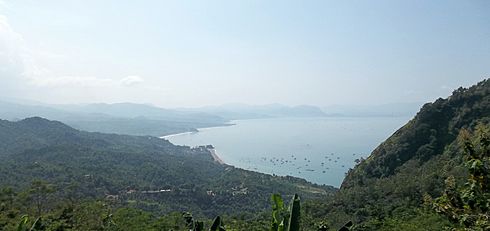Thomas Cavendish's circumnavigation facts for kids
Quick facts for kids Thomas Cavendish's circumnavigation |
|||||||
|---|---|---|---|---|---|---|---|
| Part of the Anglo–Spanish War | |||||||
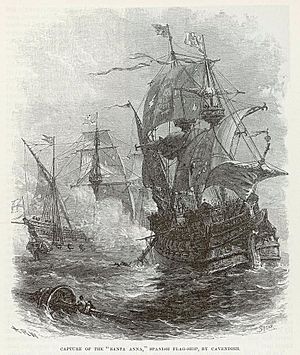 Cavendish captures the Spanish treasure galleon Santa Ana off Cabo San Lucas |
|||||||
|
|||||||
| Belligerents | |||||||
| Commanders and leaders | |||||||
| Tomás de Alzola | Thomas Cavendish | ||||||
| Strength | |||||||
| Various Spanish ports & shipping | 3 ships 126 sailors and soldiers |
||||||
| Casualties and losses | |||||||
| 3 settlements plundered 1 Galleon captured 12 other ships captured or burned |
2 ships lost 78 killed, drowned or captured |
||||||
Thomas Cavendish's circumnavigation was an exciting journey of exploration and raids led by English sailor Thomas Cavendish. It happened during the Anglo–Spanish War, from July 21, 1586, to September 9, 1588. Cavendish was inspired by Francis Drake, who had already sailed around the world. Cavendish wanted to do the same, making his trip the first planned voyage around the globe.
He started with three ships. His crew raided three Spanish towns and captured or burned thirteen ships. One of his biggest prizes was a huge 600-ton Spanish treasure ship called the Santa Ana. This ship carried the most treasure ever taken by the English. Cavendish returned to England with only one ship left, the Desire. He completed his trip around the world in record time. This journey made Cavendish very rich from all the gold, silk, and other treasures he captured. Queen Elizabeth I of England later made him a knight.
Contents
- Why Cavendish Sailed: A New Adventure
- The Journey Begins
- What Happened Next
- Cavendish's Lasting Mark
- Images for kids
Why Cavendish Sailed: A New Adventure
On December 15, 1577, Francis Drake, another English sailor, left Plymouth. He wanted to raid Spanish treasure ships and towns in the Americas. Drake's journey was funded by investors hoping to get rich from captured goods. After almost three years, Drake returned to England in his ship, the Golden Hinde. He had successfully sailed around the world. His investors made huge profits, which made others want to try similar trips. Queen Elizabeth I also made Drake a knight.
After Drake's raids, Spain felt their colonies were not safe. They started building stronger forts and a new navy in South America. This made King Philip II of Spain even more upset with England. The two countries were already fighting in the Dutch Revolt. Soon, open war began in 1585, especially after Queen Elizabeth I executed Mary Queen of Scots.
Meanwhile, Thomas Cavendish was a young man who had inherited money. He used some of it to buy a ship called the Elizabeth. In 1585, he joined an expedition to Virginia and captured a large Spanish ship. This experience made Cavendish want to follow Drake's path. He planned his own voyage to raid Spanish ports and ships. He also aimed to sail around the world. Cavendish used all his land as a guarantee and raised about £10,000 for his trip.
He got permission for his raids and built a new, larger ship called the Desire. It weighed 120 tons and had eighteen cannons. Two other ships joined him: the Content (60 tons, ten cannons) and the Hugh Gallant (40 tons, a supply ship). His crew included 123 men and boys. Some had even sailed with Drake. The crew brought tools, a portable forge, and lots of salt to preserve food.
The Journey Begins
On July 21, 1586, Cavendish left Plymouth Sound with his three ships. Five days later, near Cape Finisterre, they had a small fight with five Spanish ships. The fight lasted for three hours until it got dark. They sailed past the Canary Islands and reached the coast of Sierra Leone in West Africa on August 21. They spent eleven days there getting food and water.
They met local people and even joined their dances. Cavendish wanted to capture a Portuguese ship. But a misunderstanding led them to burn a native village instead. They took what little they could find. The locals fought back with poisoned arrows. One English sailor was hit and later died before they sailed away.
Across the Atlantic to South America
In early September, Cavendish left Africa and sailed across the Atlantic Ocean. He was heading for Portuguese Brazil. After getting water in the Cape Verde Islands, they reached an island near São Sebastião, São Paulo on November 1, 1586. They took on more water and built a small boat. Four days later, they continued south.
By mid-December, Cavendish sailed further down the East coast of South America. He found a good harbor and named it Port Desire, after his main ship. They met a few Native Americans who shot arrows, wounding some of the crew. Since there was little fresh water, Cavendish sailed on. He reached the Strait of Magellan on January 6, 1587, where they faced a strong storm.
Through the Strait of Magellan
Cavendish's three ships entered the Strait of Magellan. They passed the narrowest parts of the Strait. First, they stopped at Santa Magdalena island. There, they quickly caught and salted two barrels of penguins for food. By January 19, 1587, they reached the ruined Spanish settlement of Rey don Felipe. Amazingly, twelve men and three women from the original 400 Spanish settlers were still alive. Cavendish did not help them, except for taking a skilled pilot named Tomé Hernandez. He removed six cannons and renamed the place 'Port Famine'.
Cavendish explored the many hidden bays and channels of Tierra del Fuego. On February 24, 1587, they finally left the strait and entered the Pacific Ocean. They then sailed up the western coast of South America.
Raids on the Spanish West Coast
Cavendish soon ran into a storm. It pushed his ships further north. The Hugh Gallant got separated from the other two ships. The storm lasted for four days, making it hard for the men to rest. They finally reached Santa María Island on March 15, 1587. A group of 70 Englishmen landed and were kindly welcomed by the native people. The natives gave them food, and the English entertained them on the captain's ship. The English traded supplies with the natives, who had valuable Spanish goods. Days later, the Hugh Gallant reappeared and rejoined the others.
Concepción, Arica, and Paita Attacks
The English ships sailed north toward Mocha Island, which they saw on March 24, 1587. By the end of the month, they arrived at Quintero, having missed Valparaiso. They anchored near Concepción. Here, they saw Spaniards on horseback, but they kept their distance. Cavendish went about eight miles inland and found the valley to be very fertile. Tomé Hernandez was sent to talk with the locals, but he escaped and warned the Spanish. About 200 Spaniards then ambushed the English while they were getting water. The Spanish were driven off, losing twenty-four men. The English lost seven men killed and nine captured. Cavendish stayed in Quintero Bay before leaving on April 5. He headed towards the port of Arica.
Before reaching Arica, Cavendish captured a small boat full of Chilean wine on April 23, 1587. He renamed it George. The next morning, a large Spanish ship and four smaller boats were captured near Arica. When Cavendish arrived at Arica, he saw the town ready for defense. He even exchanged cannon fire with the Spanish forts. He decided not to land and storm the town. Instead, he burned three more ships in the harbor before sailing northwest two days later. The captured cargo included wine and important messages.
On May 14, 1587, Cavendish reached Pisco. Three days later, he captured two Spanish merchant ships, which he robbed and burned. The English ships then split up to carry out their own raids. Two days later, the Hugh Gallant captured a 300-ton ship carrying timber. But it was sinking, so they left it. The Hugh Gallant then attacked Paita four days later, capturing a boat in the harbor. Sixty men went ashore to take over the town. Its 300 people fled inland. The English demanded money, but the citizens refused. So, the English burned the houses and sailed north. They took about twenty-five pounds of silver pesos from the town.
Puna Island and Huatulco Raids
The ships reunited and anchored off Puná Island on May 25, 1587. Cavendish planned to repair his ships there. The crew found the island beautiful with lots of fruit. However, about sixteen of Cavendish's men were surprised by a large group of Spaniards and Native Americans. They came from Quito. The English fought back and gained the upper hand when Cavendish landed with more men. They drove off the Spanish, killing about 46 of them. The English lost nine sailors and three were captured. Cavendish then ordered all of Puná's buildings, ships, and crops to be burned. About 300 buildings were set on fire. A 250-ton ship was burned, and four more ships being built were looted and burned. The church was also burned, and its bells were taken. The English stayed, taking everything valuable, before sailing on.
While in a bay near Guayaquil on June 5, 1587, Cavendish decided to abandon the Hugh Gallant and the George. They didn't have enough men to crew them, and repairs would take too long. They stripped both ships of useful items before setting them on fire. They left eleven days later. They sailed north for over a month before seeing New Spain.
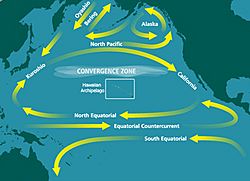
News of the raids reached Panama by early July. Two ships were sent to stop the English, but they were two weeks too late. News also reached Álvaro Manrique de Zúñiga, the Viceroy of New Spain, but it was too late for him to send orders.
On July 9, 1587, Cavendish captured a ship without cargo. But one of the captured pilots said that a Manila galleon was expected in October or November. It usually stopped at Cabo San Lucas before going to Acapulco. More proof came when another ship was captured. This ship was supposed to warn the galleon about the English raiders.
Two weeks later, Cavendish entered the Copalita River near Huatulco. A small boat with thirty men went up the river at night. They captured a boat from Sonsonate loaded with cacao and indigo. On August 2, 1587, Cavendish himself arrived at Huatulco. He captured the town and looted everything within seven miles for a week. The raids were profitable. Before leaving, he set the buildings on fire. He did the same to a merchant ship in the harbor before heading further north.
Cavendish next landed at Barra de Navidad on August 24, 1587. The English captured the Spanish lookout. Then, they destroyed two 200-ton ships that were being built. The English sailors also captured a messenger carrying the viceroy's warning about the English. They then set fire to any buildings near the lagoon.
On September 5, 1587, Cavendish sailed to the empty bays of Santiago and Salagua near Manzanillo. The English stayed for a week, getting water and supplies. They also enjoyed swimming and diving for pearls. Moving up the coast, Cavendish anchored at Tenacatitia Bay. He took thirty men inland to the village of Acatlan. They burned most of the houses and damaged the church. Leaving the bay on September 14, Cavendish went to Chacala, a sheltered bay, but found very little. They did capture two prisoners. They held them hostage until others brought them food to release them. The locals agreed. After loading fresh fruits, bread, and other food, Cavendish continued his voyage.
After leaving Chacala on September 20, 1587, Cavendish sailed past Compostela. He anchored in one of the Tres Marias islands for five days. There, they caught some iguanas and birds. On October 4, the two English ships moved on. Needing repairs, they anchored in the port of Mazatlán. There, they cleaned and balanced their ships. Cavendish then headed to the southwestern tip of Baja California. He spent over a month at a place he called 'Aguada Segura', which is likely San Lucas Bay or San José del Cabo. Here, Cavendish decided to wait for the Manila galleon.
The Manila galleons were large Spanish ships. The King of Spain allowed only one or two per year. They carried all the goods gathered in the Spanish Philippines from a year of trading. These goods included silver from American mines, traded with the Chinese and others for spices, silk, gold, and other expensive items. In 1587, there were two Manila galleons: the San Francisco and the Santa Ana. Both faced a typhoon after leaving the Philippines and were wrecked near Japan. Only the Santa Ana could be saved. After repairs, it continued its voyage.
Capturing the Santa Ana Galleon
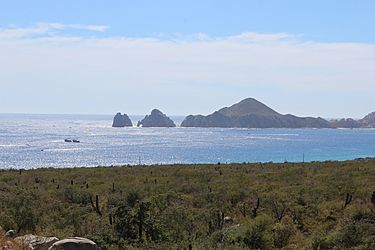
Early on November 4, 1587, one of Cavendish's lookouts spotted the 600-ton galleon. It had over 200 men and was near Cabo San Lucas. After a chase of several hours, the English ships caught up to the Santa Ana. Luckily for Cavendish, the Santa Ana had no cannons on board, to make room for more cargo. After hours of fighting, Cavendish used his cannons to fire at the galleon. The Spanish tried to fight back with small guns. The Santa Ana was badly damaged and had many holes below the waterline.
With his ship taking on water, the Spanish captain, Tomás de Alzola, did not want to surrender. But his pilot begged him to save his crew's lives in exchange for the goods on board. Realizing he had no choice, de Alzola surrendered. The battle cost the English two killed and ten wounded. The Spanish had twelve killed and fifty wounded. The English tied their ships to the Santa Ana and towed it into Aguada Segura.
Because the Santa Ana was so much larger, the Content and Desire had to choose which valuable cargo to take. One hundred ninety Spanish and Filipino crewmen were captured. Cavendish kept two Japanese sailors and three boys from Manila. A Portuguese traveler who knew about China and the pilot Alonso de Valladolid joined the English. The prisoners helped load all the gold (about 100 pounds worth) and the English picked through the silks, spices, wines, and other supplies. The total value of the cargo was said to be about 2,100,000 pesos. English sailors took what they wanted, and the less valuable items were thrown overboard. The Spanish crew were released with food, water, and even weapons to defend themselves. On November 17, 1587, the English celebrated their victory. They ate, drank, fired cannons, and had fireworks. Finally, the Santa Ana was set on fire and left to burn.
The Desire and Content sailed away the next day to continue their journey north. After the fire on Santa Ana died out, the Spanish survivors built a raft. They used it to get help from nearby Colima. They were rescued and taken to Acapulco on December 7, where they shared news of the capture.
Across the Pacific Ocean
In October, Cavendish and his two ships reached the Gulf of California. They stopped at an island above Mazatlan to clean and repair their ships. After this, the Desire and Content sailed away on November 17, 1587, to begin their journey across the Pacific Ocean. After they sailed off, the Content separated from the Desire during the night. Cavendish thought they had returned to England. But the Content and her crew were never seen or heard from again.
After a fast trip across the Pacific, Cavendish and the Desire arrived at Guam on January 3, 1588. There, he traded iron tools for fresh supplies, water, and wood from the native people. Then, he set off westward.
In the Spanish Philippines
Cavendish sailed past the Mariana Islands towards the Spanish Philippines. He touched down at northeastern Samar on January 14, 1588. The Desire passed through the narrow San Bernardino Strait into the Sibuyan Sea, then sailed south to Panay. Near Manila, the English realized they were not strong enough to attack the capital. The Portuguese pilot on board, Roderigo, claimed that the Spanish pilot, Tome de Alzola, was trying to send a letter to the natives to attack the English. The letter was found, revealing Cavendish's actions and location. Alzola was removed from the ship.
Soon after, they needed more food. They searched for a place free of Spanish presence. The Desire anchored off Capul island. Cavendish spent several days with a native chief who traded vegetables, hens, and hogs for linen and captured Spanish money.
Because the Desire carried valuable cargo, Cavendish did not want to attack other ships. He did raid a large house belonging to Bishop Domingo de Salazar, taking its contents. An attempt to surprise a galleon being built at Areval shipyard failed when the landing party was discovered early. They returned to the Desire without losses. Cavendish learned a lot about Japan and the Chinese coast, hoping to use this information for a future trip. He also got a large map of China.
Stopping in Java
Cavendish was now eager to return to England. After leaving the Philippines, they passed the Moluccas and the island of Bali. They arrived at Lombok on March 1, 1588. Five days later, he anchored at the west end of Java island, in Palabuhanratu Bay. The natives were at first unfriendly. But a sailor who spoke a dialect of Arabic helped them communicate. Through him, the English got food and water during their four days there. The native chief was entertained on the Desire with music.
Two Portuguese visitors from a nearby trading post also came after hearing about the English. They were friendly and welcomed aboard. They were worried about their king's fate. They said the Spanish had told them their King António, Prior of Crato was dead. They were happy when Cavendish told them their king was alive and in England. The Portuguese men shared many details about the region's politics and Java's riches. The natives also promised a good welcome if the English returned.
From the Indian Ocean to Saint Helena
On March 16, 1588, Cavendish said goodbye to the natives and Portuguese in Java. He sailed westward across the Indian ocean. The journey was fast until May 10, when a storm hit. Four days later, through the mist, they found False Bay off Southern Africa. They got water and gathered fruit there. Cavendish mistakenly thought this was the Cape of Good Hope. The Desire sailed north into the Atlantic without more storms. They stopped at Saint Helena island on June 8. Cavendish intended to get supplies. He became the first Englishman known to visit the island, which was occupied by the Portuguese, though he met none. Here, the ship was cleaned and restocked with turkeys, partridges, goats, and wild hogs from the island. Cavendish stayed for two weeks, exploring the island and noting its steep valleys and many fruit trees.
Returning Home to England
Around the end of August, they passed the Azores. On September 3, 1588, they met a ship from Lisbon. This ship told them about the defeat of the Spanish Armada, which made the Englishmen very happy.
Early in September, Cavendish, with his last ship Desire and his men, entered the English channel. They were hit by a storm that tore their sails. They had just missed the Spanish Armada ships, which had faced the same storm while heading to Santander. Nevertheless, on September 9, 1588, the Desire finally sailed into Plymouth harbor. The local people cheered loudly.
What Happened Next
At twenty-eight years old, Cavendish became the second Englishman to sail around the world. The Desire was only the third ship to complete a circumnavigation. The first was the Victoria (part of Ferdinand Magellan's journey, completed by Juan Sebastián Elcano). The second was Francis Drake's Golden Hind. Cavendish and Drake's trips helped future English sailors explore even more distant places.
Cavendish's voyage was a huge financial success. More importantly, it was a big win for England's image. Sailing around the world, capturing the Spanish galleon Santa Ana, and the safe return of the Desire—along with the recent defeat of the Spanish Armada—were celebrated across England. Cavendish became very popular, and songs were written about him. After resting, the Desire and its crew were paraded up the River Thames through London. The ship had new blue sails. Queen Elizabeth I made Cavendish a knight and invited him to dinner on the Desire. He was warmly welcomed at court and became much richer from his adventure.
Cavendish's trip around the world took two years and 49 days. This was nine months faster than Drake's journey. Like Drake, Cavendish returned with only one of his ships, the Desire, and about 48 men. The expedition lost about thirty people, but 76 percent of the crew survived, which was a high rate for such a long journey.
For the Spanish, Cavendish's entry into the Pacific Ocean was a second blow to their pride. Bishop Salazar in the Philippines complained to King Philip II that "an English youth at about 22 years, with a wretched little vessel of about 100 tuns, 40 to 50 companions boasted of the damage he had wrought, and went away laughing."
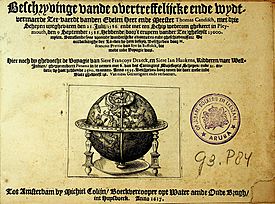
Cavendish went on a second expedition in August 1591, with navigator John Davis. They went further south to the Strait of Magellan. Then they returned to Brazil, where they resupplied and looted Santos and São Vicente. Cavendish set off across the Atlantic towards Saint Helena with the rest of his crew. But he died of unknown causes at age 31, possibly near Ascension Island in the South Atlantic, in 1592.
Because these expeditions were somewhat against the law, Francis Pretty's official records were kept secret. The first unofficial accounts were published in Dutch by Emanuel van Meteren. He bought both Drake's and Cavendish's diaries and mixed parts of them. Parts of both diaries were also included in Richard Hakluyt's books about British explorations in North America. Hakluyt finally published Cavendish's diary completely in 1600.
The Dutch were the next to try sailing around the world like Drake and Cavendish. Simon de Cordes and Oliver Van Noort completed their own raiding trips against the Spanish. The next English circumnavigation would not happen for another century, when William Dampier became the first person to sail around the world three times.
Cavendish's Lasting Mark
Puerto Deseado in Argentina is named after Cavendish's ship, the Desire. There is also a point of land at the harbor mouth still known as Punta Cavendish.
Images for kids




